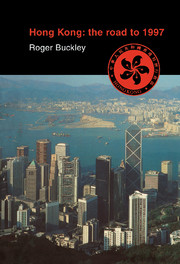Book contents
- Frontmatter
- Contents
- Preface
- Acknowledgements
- Glossary
- Map: Hong Kong, 1997
- Introduction: prewar colony
- 1 Reoccupation: postwar comeback, 1945–7
- 2 Consolidation: the Grantham years, 1947–58
- 3 Growth: the 1960s
- 4 Transformation: the MacLehose years, 1971–82
- 5 Negotiations: Sino-British diplomacy, 1982–92
- 6 Confrontation: the Patten years, 1992–5
- 7 Future: to 1997 and beyond
- 8 Conclusions: endgame
- Appendixes
- Bibliography
- Index
2 - Consolidation: the Grantham years, 1947–58
Published online by Cambridge University Press: 20 November 2009
- Frontmatter
- Contents
- Preface
- Acknowledgements
- Glossary
- Map: Hong Kong, 1997
- Introduction: prewar colony
- 1 Reoccupation: postwar comeback, 1945–7
- 2 Consolidation: the Grantham years, 1947–58
- 3 Growth: the 1960s
- 4 Transformation: the MacLehose years, 1971–82
- 5 Negotiations: Sino-British diplomacy, 1982–92
- 6 Confrontation: the Patten years, 1992–5
- 7 Future: to 1997 and beyond
- 8 Conclusions: endgame
- Appendixes
- Bibliography
- Index
Summary
Until conditions change, we intend to remain in Hong Kong. (Foreign Secretary Ernest Bevin to Secretary of State Dean Acheson, 13 September 1949)
Hong Kong is Different. (Sir Alexander Grantham, Corona, January 1959)
Once Sir Alexander Grantham was appointed as Young's successor the writing was on the wall for Hong Kong's ‘New Deal’. Grantham, an old Hong Kong hand who had first arrived in the colony as a cadet in 1922, was chosen with the full knowledge that he wanted as little as possible to do with constitutional change. He had made his views plain in correspondence and meetings with officials in London prior to the formal announcement of his posting. Grantham, who would later claim in public that ‘the problem in Hong Kong is different from that in other colonies, for Hong Kong can never become independent’, wanted no truck with the Young Plan. The new governor, knowing his territory from interwar experience, was adamant that it was best to let sleeping dogs lie. He saw his task as largely to continue with the reconstruction of Hong Kong and to provide an efficient and inexpensive administration that would take all necessary political decisions to further these economic and social ends. Grantham ran a benevolent despotism, while keeping a careful eye on the changing Chinese scene across the border.
In the short and medium term he was entitled to his opinions.
- Type
- Chapter
- Information
- Hong Kong: The Road to 1997 , pp. 31 - 53Publisher: Cambridge University PressPrint publication year: 1997



